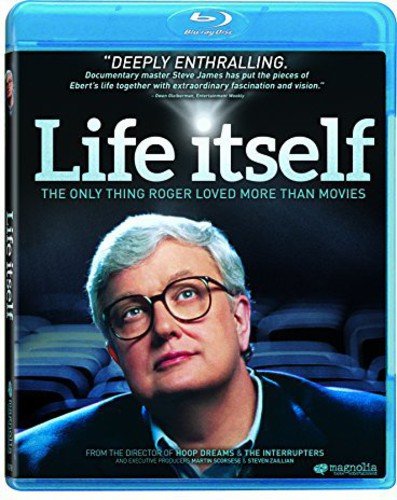
Do you think you know Roger Ebert? Believe me, whatever you know, you know only part of the story. Just a few of the late critic’s achievements:
● Winning a Pulitzer for film reviewing in 1975, the first critic to do so (take that, Pauline Kael!)
● With Gene Siskel, turning film critics into TV stars courted by Hollywood power players seeking the elusive Two Thumbs Up!™
● Writing the screenplays to Beyond the Valley of the Dolls and Beneath the Valley of the Ultra-Vixens
● Diving headlong into online and social media venues when illness robbed him of his voice
● Sobering up and going public with how he did it
● Being the subject of a compelling documentary directed by Steve James
Life Itself is a glowing yet tough-minded portrait of Roger Ebert. It doesn’t flinch from showing the way his battle with cancer of the thyroid and salivary glands ravaged him, eventually leaving him with no lower jaw at all, taking away not only his ability to speak but to eat and drink. Note for the squeamish: there’s a scene early on of Ebert being fed through a nasal tube that is difficult to watch – and that makes a mockery of anyone claiming forced feeding isn’t a form of torture. But I digress.
It was a voice that became familiar to millions of people who watched him shout, spar and sulk with the equally sharp-witted Gene Siskel, an unlikely match of two less-than-photogenic guys that we can now see was made in TV heaven. The secret to their success was not just that they both knew a ton about movies but that they both loved movies – loved them so much that they could both be disappointed when the movies they saw didn’t live up to their potential.
Eventually that nasal, Midwestern, sure-of-itself honk was replaced with a computer-generated voice, a la Stephen Hawking’s, that kept him in communication with the world and his beloved wife Chaz, who is also heavily featured in James’ documentary. As with Ebert’s deteriorating physical condition, James doesn’t shy away from showing the strain that caregiving places on even the strongest relationships, even with the resources that money and the best medical care provide. Chaz, no shrinking violet herself, has to take charge without relegating Roger to a subsidiary role, a challenge that resonates with anyone caring for a strong person struggling to still be heard.
James also provides info on Ebert’s childhood and entrée into journalism at the University of Illinois, along with his early hard-drinking, hard-partying years at the Chicago Sun-Times. It becomes clear that Ebert had long been self-destructive along with being driven, curious, and a damn good writer. He was a major drinker (and eater), two facts that success did little to change. It was Ebert himself who not only took the 12-step route that brought him sobriety but who went public with it, displaying both courage and candor.
James also shows the less-then-admirable aspects of Ebert, particularly in some grimly funny outtakes from a promo recording session with Siskel. Ebert is bossy, cutting, and snide as he fights to get things his own way. Whatever animosity showed through in the hundreds of shows he and Siskel did had its basis in a fierce, and sometimes ugly, competitiveness. Yet the loss of Siskel, who died in 1999 from his own tragic illness, a brain tumor, hit Ebert hard. They were like two really smart brothers competing for our attention, each unafraid to use the weapons at hand but loving each other just the same.
There’s more – a lot more, in fact – and most of it will be of interest to both ordinary film fans and fanatics. In fact, the two-hour documentary is more than a bit overstuffed: James had a wealth of material to choose from given Ebert’s very full life, plus the built-in arc of his final illness and death in 2013, so I’m sure it was tough to decide what to keep and what to discard. But some judicious editing to keep things moving along would have been welcome.
Like its subject, Life Itself is flawed, funny, touching, and very human. I’ll give it one-and-a-half thumbs up.